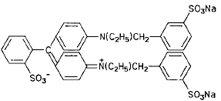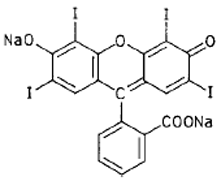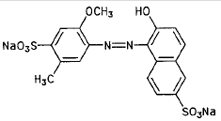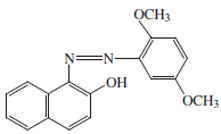Color Additives in Foods
Colored substances are added to foods to modify the appearnce of insufficiently colored or discolored foods and to create new foods. The following criteria must be met if a food color (colorant) is to be used;- it must be safe at the level and under the conditions of use;
- it must be stable in the products in which is added;
- it must not impart any offensive property (flavor, texture) to the product;
- it must be easy to apply;
- it must have a high tinctorial power; and
- it must not be too costly.
When a new color is to be introduced, the petitioner is expected to provide data proving that the new additive is safe and effective. The safety tests are elaborate and expensive. They include chronic toxicity feeding tests with two animal species over several generations. The effectiveness tests include long-term color stability experiments in the foods to which the color is to be added.
TABLE IV Permanently Listed Food Colors Subject to Certification
| Color | Structure | Usesa |
|---|---|---|
| FD&C Blue #1 |  |
Used in amounts consistent with GMP |
| FD&C Green #3 |  |
Used in amounts consistent with GMP |
| FD&C Yellow #5 |  |
Used in amounts consistent with GMP |
| FD&C Red #3b |  |
Used in amounts consistent with GMP |
| FD&C Red #40 |  |
Used in amounts consistent with GMP |
| Orange B |  |
Coloring sausage surfaces or casings (150 ppm max. based on finished product) |
| FD&C Blue #2 |  |
Used in amounts consistent with GMP |
| FD&C Yellow #6 |  |
Used in amounts consistent with GMP |
| Citrus Red #2 |  |
In skins of oranges that are not intended for processing (at 2 ppm max., based on whole fruit) |
| a GMP. Good manufacturing practices. b The FDA has recently banned the use of Red #3 in such products as cake frostings, certain processed foods, cough drops, and lipstick, in which the color is mixed with other additives reacting with it. This dye can still be applied directly to meat, nut products, fruit and fruit juices, candy, confections, and breakfast cereals. |
||
The food color additives subject to certification are listed in Table IV. The initials FD&C stand for the Food, Drug & Cosmetic Act under which these additives are regulated. The food color additives exempt from certification are listed in Table V. Generally, only synthetic organic colorants are subject to certification, while natural organic and inorganic colors, such as paprika and titanium oxide are not. The colorant β-carotene is not subject to certification whether it is obtained from a natural source or it is synthetically produced.
TABLE V Permanently Listed Colors Exempt from Certification
| Colorant | Usesa | Colorant | Usesa |
|---|---|---|---|
| Caramel | In foods, generally consistent with GMP | Cochineal extract; carmine | In foods, generally consistent with GMP |
| β-Carotene | In foods, generally consistent with GMP | Dehydrated beets | In foods, generally consistent with GMP |
| Annatto extract | In foods, generally consistent with GMP | Riboflavin | In foods, generally consistent with GMP |
| Paprika | In foods, generally consistent with GMP | Carrot oil | In foods, generally consistent with GMP |
| Paprika oleoresin | In foods, generally consistent with GMP | β-Apo-8´-carotenal | In foods, generally not to exceed 25 mg/lb |
| Turmeric | In foods, generally consistent with GMP | Titanium dioxide | In foods, generally not to exceed 1% by weight |
| Turmeric oleoresin | In foods, generally consistent with GMP | Grape skin extract | In still and carbonated beverages and alcoholic beverages |
| Saffron | In foods, generally consistent with GMP | Ferrous gluconate | For coloring ripe olives, consistent with GMP |
| Fruit juice | In foods, generally consistent with GMP | Canthaxanthin | In foods, generally not to exceed 30 mg/lb |
| Vegetable juice | In foods, generally consistent with GMP | ||
| Toasted, partially defatted, cooked cottonseed flour |
In foods, generally consistent with GMP | ||
| a GMP, Good manufacturing practices. | |||
While synthetic food dyes are generally water-soluble, food lakes are water-insoluble. Food lakes are prepared by precipitating dyes on alumina. These lakes are useful for coloring water-repelling foods, such as fats and oils, certain gums, as well as packaging materials, e.g., plastic films, lacquers and inks, from which soluble dyes would leach out. Listing of a food dye does not necessarily imply listing the corresponding lake.
Polymeric food dyes have been developed that cannot pass the gastrointestinal wall and are excreted virtually intact in the feces. Toxicity and efficacy tests must be completed before FDA approval is granted to these dyes.
In recent years, plant tissue culture techniques have been applied to the production of food colors. Also the pigments of two fungi: Monascus anka and Monascus purpureus are being considered for use in foods. These fungal pigments have been used as food colors and medicines in the Far East for hundreds of years.
The regulations regarding color additives can be found in the Code of Federal Regulations, Title 21, Parts 70–82. Changes in these regulations are published in the “Federal Register.” Additional information on color additives can be obtained from:
Food & Drug Administration,
Division of Color & Cosmetics,
200 C Street. S. W. Washington, DC 20204.




